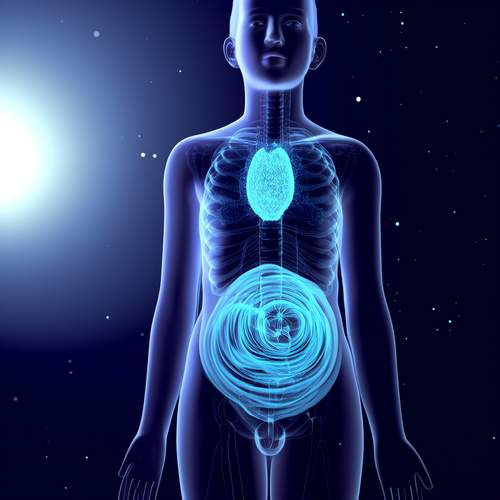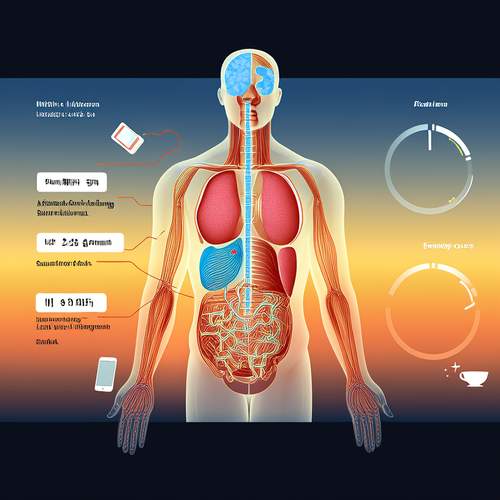The human body operates on an intricate internal clock known as the circadian rhythm, which governs numerous physiological processes. Among these, the secretion of melatonin—a hormone primarily produced by the pineal gland—plays a pivotal role in regulating sleep-wake cycles. Unlike other hormones that surge during the day, melatonin is unique in its nocturnal release, peaking in the middle of the night and tapering off by dawn. This natural ebb and flow are finely tuned to environmental light cues, making it a cornerstone of our biological connection to the day-night cycle.
Melatonin synthesis begins with the amino acid tryptophan, which converts into serotonin before ultimately transforming into melatonin. This process is heavily influenced by light exposure. Specialized cells in the retina detect ambient light and send signals to the suprachiasmatic nucleus (SCN) in the hypothalamus, the body’s master clock. When darkness falls, the SCN prompts the pineal gland to ramp up melatonin production. Conversely, exposure to bright light—especially blue light from screens—can suppress this secretion, disrupting sleep patterns. This sensitivity to light underscores why modern lifestyles, with their artificial illumination and late-night device use, often interfere with melatonin’s natural rhythm.
Beyond its sleep-inducing effects, melatonin serves as a powerful antioxidant, scavenging free radicals and reducing oxidative stress. Research suggests it may protect against neurodegenerative diseases like Alzheimer’s by mitigating cellular damage in the brain. Its anti-inflammatory properties also hint at potential benefits for immune function, though the mechanisms remain under investigation. Interestingly, melatonin receptors are found throughout the body—not just in the brain—indicating its far-reaching influence on systems like cardiovascular health and glucose metabolism.
Age dramatically alters melatonin production. Infants produce minimal amounts until about three months old, coinciding with the development of more regular sleep patterns. Levels peak in childhood and adolescence, then decline steadily with age. This drop may explain why older adults often experience fragmented sleep or early waking. Seasonal changes further modulate secretion; shorter winter days can prolong melatonin release, contributing to seasonal affective disorder (SAD) in susceptible individuals. Such variations highlight the hormone’s role as both a timekeeper and a mediator of environmental adaptation.
Artificial melatonin supplements have surged in popularity as sleep aids, but their use remains contentious. While short-term supplementation can help reset disrupted circadian rhythms—such as in jet lag or shift work—long-term effects are less clear. Overuse may blunt the body’s natural production or alter hormone sensitivity. Moreover, dosage varies widely; some pills contain up to 10 times the endogenous amount the body typically secretes. Unlike pharmaceuticals, melatonin is marketed as a dietary supplement in many countries, escaping rigorous FDA oversight, which raises concerns about consistency and safety.
The interplay between melatonin and other hormones adds another layer of complexity. Cortisol, the stress hormone, follows an inverse rhythm, peaking in the morning to promote wakefulness. Disrupted melatonin levels can throw this antagonistic balance into disarray, perpetuating cycles of poor sleep and heightened stress. Thyroid hormones and reproductive hormones like estrogen also interact with melatonin, suggesting its broader endocrine implications. For instance, shift workers with chronically suppressed melatonin show higher rates of menstrual irregularities and certain cancers, though causation remains unproven.
Emerging therapies are exploring melatonin’s potential beyond sleep. Low-dose formulations combined with light therapy show promise for treating circadian disorders in blindness, where patients lack light perception to regulate secretion. Some oncologists are investigating high-dose melatonin as an adjunct to chemotherapy, capitalizing on its antioxidant effects to protect healthy cells. However, these applications require careful calibration, as melatonin’s biphasic nature—beneficial at low levels but potentially pro-oxidant at high doses—complicates its therapeutic use.
Lifestyle adjustments remain the most sustainable way to optimize natural melatonin secretion. Dimming lights in the evening, maintaining consistent sleep schedules, and avoiding screens before bed can enhance production. Dietary sources like tart cherries, walnuts, and oats provide small amounts of melatonin precursors, though their impact pales compared to endogenous synthesis. For those grappling with chronic insomnia or circadian disorders, consulting a specialist ensures melatonin—whether endogenous or supplemental—is harnessed effectively without undermining the body’s delicate hormonal orchestra.
In essence, melatonin transcends its reputation as a simple sleep hormone. It bridges our biology with the environment, modulates diverse bodily functions, and reflects the profound ways modern life strains our evolutionary design. As research unravels its multifaceted roles, one truth becomes clear: respecting this hormone’s natural rhythm is not just about better sleep—it’s about aligning with the primal cadence that shapes human health.

By /May 21, 2025

By /May 21, 2025

By /May 21, 2025

By /May 21, 2025

By /May 21, 2025

By /May 21, 2025

By /May 21, 2025

By /May 21, 2025

By /May 21, 2025

By /May 21, 2025

By /May 21, 2025

By /May 21, 2025

By /May 21, 2025

By /May 21, 2025

By /May 21, 2025

By /May 21, 2025

By /May 21, 2025

By /May 21, 2025

By /May 21, 2025

By /May 21, 2025